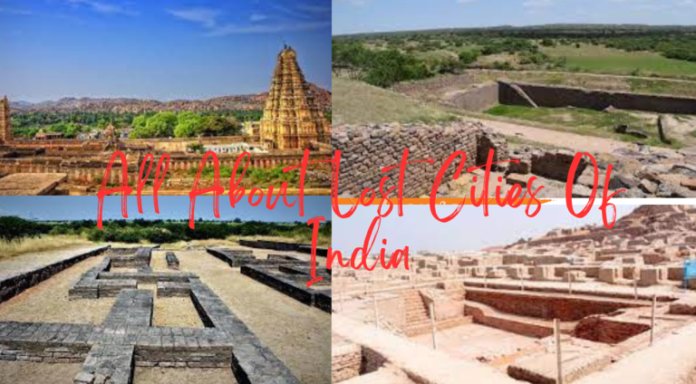10 Legendary Mysterious Lost Cities In India
There are some hidden cities that have been discovered in India and have come into the limelight in just a few years. These cities read on to know about the lost cities in India:
Rakhigarhi – An large Settlement
Vijayanagar – The Kishkinda Of Ramayana
Lothal – Interesting shambles
Dholavira – A Planned City Of Old Times
Kalibangan – Earliest Ploughed Agrarian Field
Dwarka – The blest City Of Lord Shree Krishna Ji
Surkotada – Ancient Mounds And shambles
Muziris – An Archaeological Site
Sanchi – An Religious Site
Nagarjunakonda – White Marble Descriptions Of Buddha’s Life
What are the Lost Cities of India?
The lost cities of India refer to ancient cities that were once inhabited but are now abandoned and lost to time. Here are some of the well-known lost cities of India:
1. Hampi: Located in the southern state of Karnataka, Hampi was the capital of the Vijayanagara Empire in the 14th century. The city is known for its impressi
2. Dholavira: Located in the western state of Gujarat, Dholavira is one of the largest and most well-preserved Harappan sites in India. The city was built around 4500 years ago and is known for its impressive urban planning and water management systems.
3. Lothal: Located in the western state of Gujarat, Lothal was an important center of the Indus Valley Civilization. The city is known for its well-preserved dockyard and the remains of a thriving trade and manufacturing industry.
4. Kalibangan: Located in the northern state of Rajasthan, Kalibangan was another important center of the Indus Valley Civilization. The city is known for its impressive fortifications, public buildings, and the discovery of the world’s earliest ploughed fields.
These lost cities offer a glimpse into India’s rich cultural and architectural heritage, and their excavation and preservation remain an important part of the country’s cultural and historical legacy.
What Caused the Decline of the Lost Cities of India?
The reasons for the decline of the lost cities of India are varied and complex. Some of the factors that contributed to the decline of these cities include:
1. Natural disasters: Many of the lost cities of India were situated in areas that were prone to natural disasters such as floods, earthquakes, and droughts. These disasters could cause widespread destruction, leading to the abandonment of the cities.
2. Environmental factors: In some cases, environmental factors such as soil degradation, deforestation, and water scarcity could make it difficult for the inhabitants to sustain themselves, leading to the decline of the cities.
3. Economic factors: Changes in trade routes or the emergence of new economic centers could lead to a decline in the importance and prosperity of certain cities. For example, the city of Hampi lost its status as a center of trade and commerce after the decline of the Vijayanagara Empire.
The decline of the lost cities of India is a reminder of the complex and interconnected factors that shape the fate of human settlements, and the importance of sustainable development and preservation of cultural heritage
Are the Lost Cities of India being Excavated?
Yes, many of the lost cities of India are being excavated and studied by archaeologists and historians. Excavations help to uncover the remains of the ancient cities, including their architecture, artifacts, and social structures, and provide valuable insights into the history and culture of the region.
The Archaeological Survey of India (ASI) is the primary organization responsible for the excavation and preservation of archaeological sites in India. The ASI has excavated many of the lost cities of India, including Hampi and Dholavira. These excavations have helped to reveal the layout and design of the cities, the lifestyles and beliefs of their inhabitants, and the economic and political structures of the time.
Excavations of lost cities in India are ongoing, and new discoveries are being made all the time. In recent years, advances in technology and scientific methods have enabled researchers to gain a deeper understanding of these ancient civilizations and the forces that shaped their rise and decline.
It is important to note that the excavation and preservation of archaeological sites must be done carefully and with consideration for the cultural and historical significance of the area. Excavations must be carried out in a manner that respects the cultural heritage of the region and ensures the long-term preservation of the site.
Can Tourists Visit the Lost Cities of India?
Yes, many of the lost cities of India are open to tourists, although access to certain areas may be restricted or limited for conservation purposes. Visiting these ancient sites can be a fascinating way to explore India’s rich history and cultural heritage.
Some of the popular lost cities of India that are open to tourists include Hampi and Dholavira. Visitors to these sites can explore the ancient ruins, temples, and other architectural structures that provide a glimpse into the lives of the people who lived there centuries ago.
However, it is important to note that visitors to these sites must respect the cultural and historical significance of the area and follow responsible tourism practices. This includes not touching or removing artifacts or structures, avoiding littering or damaging the environment, and following local rules and regulations.
Additionally, visitors to these sites should be aware that the ruins may be in a state of disrepair and may not be fully accessible or safe to explore. It is recommended to hire a guide or join a tour group to ensure a safe and informative visit.
Overall, visiting the lost cities of India can be a rewarding experience for those interested in history, culture, and archaeology.

